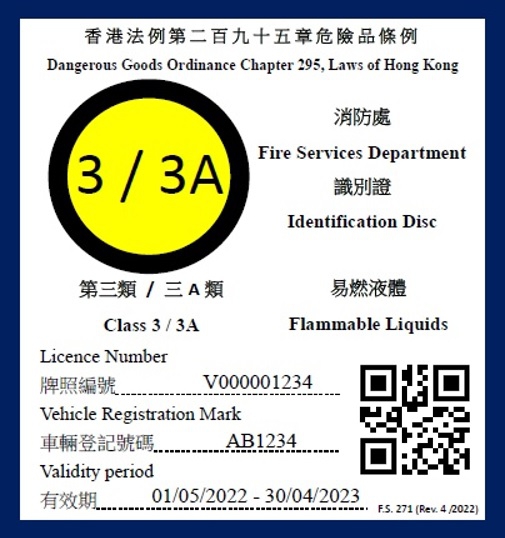Frequently Asked Questions
Main Content
III. Dangerous Goods Licence/
Approval Application and Exemption
The previous approval of gas cylinders and diesel fuel tanks in accordance with the DGO will still be valid under the amended legislation. Reapplication in accordance with the legislation is not required.
Dangerous goods in consumer packs (“DGCP”) are exempted from requirements of conveyance licence as well as packing, marking and labelling. However, a storage licence has to be applied for in accordance with the Dangerous Goods Ordinance if the quantity stored exceeds the exempt quantity for storage of DGCP in the premises concerned.
DG with package size not exceeding the “limited quantity” will be exempted from the marking and labelling requirements. Other requirements such as packing, storage and conveyance shall be complied with as in the case of general DG.
The exempt quantity for dangerous goods in consumer packs (“DGCP”) and non-DGCP are calculated separately. Both DGCP and non-DGCP can be stored together without licence as long as they do not exceed their respective exempt quantity.
Exempt quantity of DG refers to the maximum quantity of DG each person (or legal person) can store without holding a DG storage licence.
The application of exempt quantity of DG will be considered independently by the Fire Services Department (“FSD”) based on the actual situation. For instance, in a construction site, it is not illegal for two unrelated and independent contractors to undergo different painting procedures using 200L of paint each in different locations in the same construction site. In a hospital, while a certain amount of rubbing alcohol is used in each building, it is not necessary for each building to apply for one independent DG store.
Nevertheless, to avoid contravening the law, any person (or legal person) should apply to the FSD for a DG licence if he or she needs to store or use DG more than the exempt quantity.
The difference is that the establishment and format of SDS are amended and standardised upon the requirements of the Globally Harmonized System of Classification and Labeling of Chemicals (“GHS”).
Applicants should provide SDS as far as possible to verify the information of the DG when applying for DG licences. If SDS cannot be provided, the Fire Services Department ("FSD") will also consider accepting MSDS as a supporting document if the MSDS clearly shows the information of the DG, such as “UN number”, “proper shipping name”, “class” and “packing group”, etc. However, since MSDS has no standards and fixed formats, applicants may be required to provide additional information to the FSD for verification.
Dangerous goods licences will become invalid in the following circumstances:
(i) The validity period expires;
(ii) The licence is revoked or cancelled;
(iii) The licence is surrendered by the licensee;
(iv) The licensed premise is demolished, destroyed or ceases to exist; or
(v) The licensee dies or ceases to exist.
Please refer to Section 99 of the Dangerous Goods (Control) Regulation (Cap. 295G) for details.
Applicants can either apply for Dangerous Goods licences on their own or authorise other agents such as contractors or consultants to apply on behalf of them.
The Fire Services Department (“FSD”) will not provide a list of contactors/consultants for the application of Dangerous Goods (“DG”) licences.
Applicants can refer to the list of Fire Service Installation (“FSI”) Contractors in the FSD website (https://www.hkfsd.gov.hk/eng/fire_protection/cert/index.html) if they need to employ eligible contractors regarding the FSI in DG stores.
A storage and use licence is required for the storage / storage and use of Schedule 2 DG on land, when the quantity of one type of DG so stored / stored and used exceeds its general exempt quantity (GEQ), industrial exempt quantity (IEQ) or special exempt quantity (SEQ) (as the case may be) of that type of DG; or when the storage / storage and use of multiple types of DG exceed the aggregate EQ of the class / type of DG concerned. The Fire Services Department (“FSD”) will not issue an independent licence for the use of DG.
In the regulation of use of DG under the DGO, the FSD mainly focuses on whether appropriate and safe storage premises are available during use. After using the DG, licensees should return them to the licensed DG store to ensure public safety. The Dangerous Goods (Control) Regulation (Cap. 295G) requires the locations at which the DG may be used to be specified. Processing, use or disposal of DG in the use area as stipulated on the licence are not under regulation of the DGO. Licensees or related persons shall comply with the requirements of the related laws in Hong Kong.
Please refer to Sections 97 and 98 of the Dangerous Goods (Control) Regulation (Cap. 295G) regarding the form and conditions of the storage and use licence.
On granting the conveyance licence, the Fire Services Department will issue an identification disc with the licence number, vehicle registration mark and validity period to the licensee.
The samples of identification disc are shown below:


The identification disc shall be displayed on the left hand side of the windscreen of the DG vehicle. If the vehicle has an engine but not a fixed windscreen, the identification disc shall be displayed at a conspicuous place on the left hand side of the front of the vehicle in a manner that the disc is clearly visible from the front of the vehicle. If the vehicle does not have an engine, the identification disc shall be displayed at a conspicuous place near the registration plate on the vehicle.
Please refer to Section 122 of the Dangerous Goods (Control) Regulation (Cap. 295G) regarding the requirements to display the identification disc.
Other than a person employed to handle DG on the vehicle, a vehicle in the course of conveyance of DG must not carry any passengers. A driver who contravenes the above terms commits an offence, and shall be liable on conviction to a fine at level 4 and imprisonment for 1 month.
Please refer to Section 136 of the Dangerous Goods (Control) Regulation (Cap. 295G) for details.
DG vehicles are only allowed to convey the DG listed on the DG licence. Mixed conveyance of Class 2 and Class 3/3A DG is prohibited.
Please refer to Section 130 of the Dangerous Goods (Control) Regulation (Cap. 295G) for details.
There are five types of exempt quantity under the amended DGO, namely:
(a) General exempt quantity: the specified quantity exempted from a Dangerous Goods (“DG”) licence in normal circumstances;
(b) Industrial exempt quantity: the specified quantity exempted from a DG licence in industrial premises;
(c) Special exempt quantity: the specified quantity exempted from a DG licence in special premises;
(d) Consumer pack exempt quantity: the specified quantity of DG in consumer pack exempted from a DG licence in uninhabited compartments; and
(e) Consumer pack (warehouse) exempt quantity: the specified quantity of DG in consumer pack exempted from a DG licence in warehouse compartments in industrial building.
Please refer to Section 2 of the Dangerous Goods (Application and Exemption) Regulation 2012 (Cap. 295E) for the definitions of different types of exempt quantity.
To satisfy the definition of “in use” as per the provisions stated in sections 98 (e) and (p) of Cap. 295G, the DG concerned must fulfill the following requirements:
(i) situated in the *use area designated in the licence;
(ii) for a reasonable intended usage, with the kind of business involved taken into consideration; and
(iii) in a reasonable quantity, with due consideration of the quantity of the S2DG generally used in that business within a certain period of time and its inherent hazards.
*remarks: when assessing the location of a proposed use area in the course of processing a store and use licence application, the following considerations may be taken into account:
(a) the surrounding environment and neighborhood of the use area as designated in the licence; and
(b) the conveyance of the S2DG between the store and the use area.


